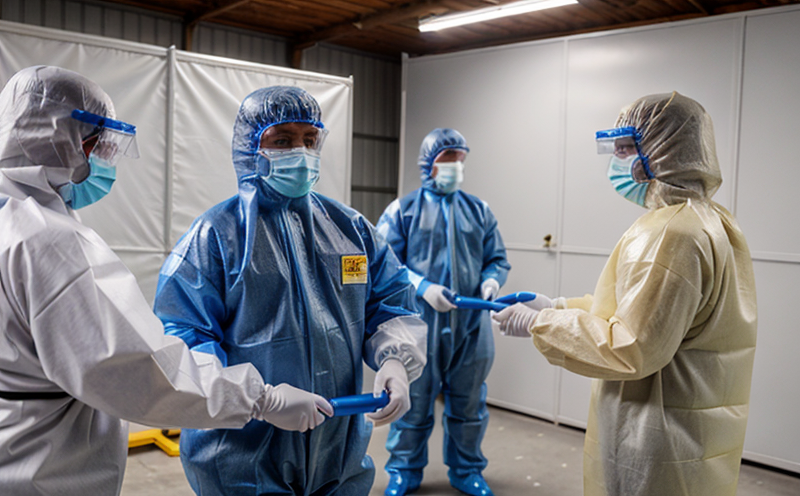BS EN 14605 Garments protecting against liquid chemicals
The British Standard and European Norm (BS EN) 14605 is a critical standard for the production, assessment, and certification of protective clothing that offers protection against chemical liquids. This service ensures compliance with this standard to safeguard workers in high-risk environments.
Protective clothing designed according to BS EN 14605 is intended for use by workers who are exposed to potentially harmful chemicals. This includes industries such as manufacturing, healthcare, and emergency services where the risk of contact with hazardous substances is prevalent. The standard specifies testing methods that determine whether garments meet the necessary criteria for protecting against chemical liquids.
The testing process involves several stages: specimen preparation, application of the test liquid, drying period, visual inspection, measurement of permeation rates, and evaluation based on acceptance criteria outlined in the standard. Compliance with these stringent requirements guarantees that workers are equipped with reliable protective gear that effectively shields them from harmful chemicals.
Understanding the intricacies of this testing is essential for quality managers, compliance officers, R&D engineers, and procurement professionals involved in selecting or developing protective clothing. By ensuring adherence to BS EN 14605, organizations can uphold a high standard of worker safety and maintain regulatory compliance within their respective sectors.
The application of this standard extends beyond mere certification; it is a testament to the commitment towards maintaining a safe work environment. The robust testing protocols ensure that protective garments are not only durable but also provide optimal protection against chemical exposure, thereby reducing the risk of injury or illness among employees.
For industries reliant on stringent safety measures, such as chemical processing plants and healthcare facilities, compliance with BS EN 14605 is non-negotiable. It underscores the importance of investing in quality protective clothing that meets international standards, thus fostering a culture of occupational health and safety.
Why It Matters
The significance of protecting workers against liquid chemicals cannot be overstated. Exposure to hazardous substances can lead to severe injuries or even life-threatening conditions if not adequately addressed. Protective clothing plays a pivotal role in mitigating these risks by creating a barrier between the worker and potentially harmful chemicals.
- Reduces the likelihood of skin contact with chemicals
- Minimizes inhalation risks associated with volatile compounds
- Promotes compliance with regulatory requirements, ensuring legal safety for workers
- Enhances overall workplace safety by reducing incidents related to chemical exposure
By adhering to the stringent testing protocols prescribed in BS EN 14605, manufacturers and suppliers can demonstrate their commitment to worker safety. This not only builds trust with clients but also sets a benchmark for excellence within the industry.
The standard is particularly relevant in sectors where workers are frequently exposed to chemicals, such as laboratories, chemical plants, and healthcare facilities. Ensuring that protective clothing meets these stringent criteria helps create a safer working environment, ultimately contributing to improved productivity and reduced absenteeism due to injuries or illnesses.
Applied Standards
| Standard | Description |
|---|---|
| BS EN 14605:2003 | This standard specifies the requirements for chemical protective clothing and provides guidance on selection, use, care, and maintenance. |
| ISO/TS 16708-1:2019 | An international technical specification that offers additional information to support the implementation of BS EN 14605. |
| Test Method | Description |
|---|---|
| Permeation Test | Measures how quickly a chemical can pass through the material of the protective garment. |
| Penetration Test | Evaluates whether a chemical breaches the surface integrity of the fabric. |
Competitive Advantage and Market Impact
- Enhances brand reputation by demonstrating commitment to worker safety
- Increases market competitiveness through compliance with international standards
- Fosters customer trust, leading to long-term relationships and repeat business
- Promotes innovation in protective clothing design and manufacturing processes
Adhering to BS EN 14605 not only sets a high standard for quality but also differentiates organizations from competitors. By prioritizing worker safety, companies can position themselves as leaders in the industry, attracting clients who prioritize occupational health and safety.





